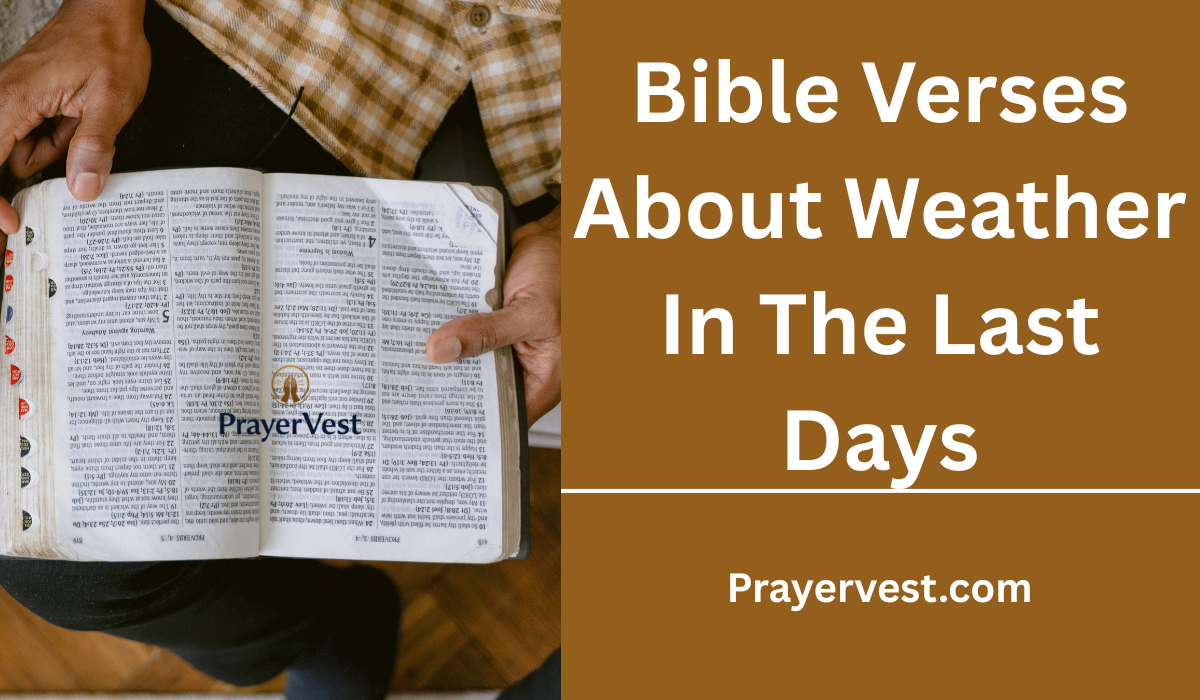The Bible uses vivid imagery when discussing the end times, frequently relating natural signals and odd weather patterns to God’s purpose. Scripture indicates that the earth itself will bear witness to impending changes, as evidenced by the Old Testament prophets and Jesus’ statements in the Gospels.
Extreme catastrophes like earthquakes, droughts, and storms are not coincidental; rather, they are indicators of God’s omnipotence and the need for immediate repentance. Therefore, the weather in the end days is closely related to prophecy, judgment, and the fulfillment of God’s Word and is not only about climate.
The weather is both a metaphor of God’s strength and a means of His wrath throughout the Bible. It turns into a signpost in the end times, alerting people to Christ’s approaching return and the imminence of His rule. These verses serve as a reminder that God controls the natural world and that even the weather will be used to draw people back to Him in the final days.
We can better understand how God’s chronology is reflected in creation and how it sets the stage for His ultimate plan by examining these texts.


Thinking back on recent weather-related Bible scriptures enables us to live more mindfully and preparedly. Believers are urged to view storms, floods, and sky signs as reminders of God’s omnipotence and the imminence of His promises rather than as causes for fear. Knowing that God is still in control, regardless of how chaotic the world may seem, these passages exhort us to observe, pray, and maintain our faith. In addition to being a natural occurrence, the recent weather serves as a spiritual reminder to seek Him out urgently and with hope.
40 Powerful Bible Verses About Weather In The Last Days (2025)
1. Matthew 24:7
“Nation will rise against nation, and kingdom against kingdom. There will be famines and earthquakes in various places.”
In this verse, Jesus warns His disciples of the signs that will precede the end times. Natural disasters such as earthquakes and famines are highlighted as indicators of the last days, showing that the created order itself will bear witness to the approaching return of Christ. This verse teaches that changes in weather and nature are not random but are part of God’s unfolding plan for the world.
2. Luke 21:25
“There will be signs in the sun, moon and stars. On the earth, nations will be in anguish and perplexity at the roaring and tossing of the sea.”
Here, Jesus describes cosmic and atmospheric disturbances that will bring fear and confusion to nations. The weather patterns, storms, and disruptions of the seas serve as prophetic signs of God’s power and the nearness of His kingdom. This verse underscores the truth that even the heavens and earth declare the urgency of God’s timetable and call humanity to repentance.
3. Revelation 16:21
“From the sky huge hailstones, each weighing about a hundred pounds, fell on people. And they cursed God on account of the plague of hail, because the plague was so terrible.”
This apocalyptic vision reveals how severe weather phenomena will be unleashed as instruments of God’s judgment in the last days. The intensity of the hailstones demonstrates the magnitude of divine power against rebellion. Instead of leading people to repentance, however, many will harden their hearts. This verse highlights both the severity of God’s justice and the danger of ignoring His warnings through nature.
4. Isaiah 13:13
“Therefore I will make the heavens tremble; and the earth will shake from its place at the wrath of the Lord Almighty, in the day of his burning anger.”
Isaiah paints a vivid picture of cosmic and terrestrial upheaval as part of God’s judgment. The shaking of the heavens and the earth symbolizes not only literal disturbances but also the collapse of worldly security. Weather, earthquakes, and natural signs become instruments pointing to God’s sovereignty. This verse reminds us that the last days will reveal the full extent of God’s power through creation itself.
5. Joel 2:30-31
“I will show wonders in the heavens and on the earth, blood and fire and billows of smoke. The sun will be turned to darkness and the moon to blood before the coming of the great and dreadful day of the Lord.”
Joel’s prophecy connects atmospheric and celestial signs to the final judgment. Unnatural changes in the sun and moon, along with earthly disasters, signal that the end is near. These verses remind us that God will use both the heavens and the weather on earth to call people to repentance before His day of reckoning arrives.
6. Nahum 1:3
“The Lord is slow to anger but great in power; the Lord will not leave the guilty unpunished. His way is in the whirlwind and the storm, and clouds are the dust of his feet.”
Nahum portrays God’s majesty and judgment through weather imagery—whirlwinds, storms, and clouds. These natural elements are not chaotic but serve as symbols of God’s authority and justice. In the last days, such manifestations will remind the world that creation itself is under His command and judgment.
7. Revelation 6:12-13
“I watched as he opened the sixth seal. There was a great earthquake. The sun turned black like sackcloth made of goat hair, the whole moon turned blood red, and the stars in the sky fell to earth, as figs drop from a fig tree when shaken by a strong wind.”
This apocalyptic vision presents a terrifying disruption of nature—earthquakes, solar and lunar changes, and falling stars. Weather patterns and cosmic signs declare God’s wrath and the imminence of Christ’s return. It reminds us that the last days will shake both heaven and earth to reveal God’s ultimate authority.
8. Jeremiah 10:13
“When he thunders, the waters in the heavens roar; he makes clouds rise from the ends of the earth. He sends lightning with the rain and brings out the wind from his storehouses.”
Jeremiah emphasizes that every aspect of weather—rain, thunder, lightning, and wind—comes directly from God’s hand. In the last days, these elements will not merely be natural phenomena but divine signs pointing to His power and judgment. This verse reminds believers to see weather as a tool God uses to communicate His will.
9. Revelation 8:7
“The first angel sounded his trumpet, and there came hail and fire mixed with blood, and it was hurled down on the earth. A third of the earth was burned up, a third of the trees were burned up, and all the green grass was burned up.”
In this revelation, devastating weather phenomena are unleashed as divine judgments. Hail, fire, and destruction to vegetation symbolize how deeply the earth will be affected in the last days. These apocalyptic weather events show the seriousness of God’s wrath against sin and humanity’s rebellion.
10. Job 37:9-10
“The tempest comes out from its chamber, the cold from the driving winds. The breath of God produces ice, and the broad waters become frozen.”
Job describes weather as a direct result of God’s power—storms, cold, and even ice respond to His command. In the context of the last days, this passage reminds us that no climate or weather shift occurs without God’s sovereign hand. What may seem uncontrollable to humans is perfectly governed by Him.
11. Haggai 2:6
“This is what the Lord Almighty says: ‘In a little while I will once more shake the heavens and the earth, the sea and the dry land.’”
Haggai prophesies a time when God will cause great upheaval in the heavens and on earth. The shaking of creation represents both judgment and preparation for His kingdom. In the last days, such cosmic and weather disturbances remind us that everything temporary will be removed so that only what is eternal may remain.
12. Revelation 11:19
“Then God’s temple in heaven was opened, and within his temple was seen the ark of his covenant. And there came flashes of lightning, rumblings, peals of thunder, an earthquake and a severe hailstorm.”
The opening of heaven’s temple unleashes dramatic weather signs—thunder, lightning, earthquakes, and hail. These events symbolize the awesome power of God’s presence and judgment. In the last days, such signs will confirm God’s sovereignty and remind humanity that His covenant promises are unshakable even amidst chaos.
13. Ezekiel 38:22
“I will execute judgment on him with plague and bloodshed; I will pour down torrents of rain, hailstones and burning sulfur on him and on his troops and on the many nations with him.”
Ezekiel’s prophecy shows God using extreme weather—hail, torrential rains, and even burning sulfur—as instruments of judgment. These apocalyptic events reveal that God controls nature and will use it in the last days to demonstrate His justice against rebellious nations.
14. Psalm 148:8
“Lightning and hail, snow and clouds, stormy winds that do his bidding.”
This psalm declares that even the weather obeys God’s commands. Lightning, hail, snow, and storms are not random but serve His purposes. In the last days, these elements will play a prophetic role, revealing that creation itself testifies of God’s sovereignty and glory.
15. Revelation 7:1
“After this I saw four angels standing at the four corners of the earth, holding back the four winds of the earth to prevent any wind from blowing on the land or on the sea or on any tree.”
This passage reveals that even the winds are under divine control. The angels restrain them until God’s appointed time. In the last days, weather and winds will be used as part of God’s plan for judgment and salvation, showing that nothing in creation moves outside His will.
16. Isaiah 24:19-20
“The earth is broken up, the earth is split asunder, the earth is violently shaken. The earth reels like a drunkard, it sways like a hut in the wind; so heavy upon it is the guilt of its rebellion that it falls—never to rise again.”
Isaiah vividly describes the earth itself convulsing under the weight of sin. Violent shaking and instability, like a hut swaying in the wind, symbolize the chaos of the last days. These weather and earth-shaking events point to God’s judgment and the end of the present age.
17. Revelation 16:8
“The fourth angel poured out his bowl on the sun, and the sun was allowed to scorch people with fire.”
In this vision, the sun itself becomes an instrument of judgment, scorching the earth with unbearable heat. Such extreme weather in the last days highlights the seriousness of God’s wrath and shows that even celestial bodies are subject to His command.
18. Amos 4:7
“I also withheld rain from you when the harvest was still three months away. I sent rain on one town, but withheld it from another. One field had rain; another had none and dried up.”
Amos reminds Israel of God’s power to give or withhold rain. In the last days, weather patterns will serve as direct instruments of God’s dealings with humanity. This passage emphasizes that drought and abundance alike are tools in God’s hands for judgment and mercy.
19. Mark 13:24-25
“But in those days, following that distress, ‘the sun will be darkened, and the moon will not give its light; the stars will fall from the sky, and the heavenly bodies will be shaken.’”
Jesus speaks of cosmic signs that will mark the end times. Darkness, falling stars, and heavenly disturbances reveal the breaking of natural order as the world prepares for His return. These weather and celestial events serve as signs urging people to be spiritually prepared.
20. Zechariah 14:6-7
“On that day there will be neither sunlight nor cold, frosty darkness. It will be a unique day—a day known only to the Lord—with no distinction between day and night. When evening comes, there will be light.”
Zechariah foretells an extraordinary disruption in weather and natural cycles during the last days. This prophecy points to God’s direct intervention in creation, establishing a unique day of divine authority. It highlights that God alone determines the times and seasons, especially at the end of the age.
21. Psalm 18:12-13
“Out of the brightness of his presence clouds advanced, with hailstones and bolts of lightning. The Lord thundered from heaven; the voice of the Most High resounded.”
This psalm describes God’s presence revealed through powerful weather—clouds, hail, lightning, and thunder. In the last days, such imagery reminds us that God’s voice can shake creation itself, and the storms of nature declare His majesty and judgment.
22. Isaiah 30:30
“The Lord will cause people to hear his majestic voice and will make them see his arm coming down with raging anger and consuming fire, with cloudburst, thunderstorm and hail.”
Isaiah portrays God’s judgment through violent weather—hail, storms, and fire. These natural forces become instruments of divine wrath. In the last days, they will serve as unmistakable signs of God’s power and justice against rebellion.
23. Revelation 15:1
“I saw in heaven another great and marvelous sign: seven angels with the seven last plagues—last, because with them God’s wrath is completed.”
The last plagues described in Revelation often manifest through catastrophic weather events, including hail, scorching sun, and storms. This verse highlights that in the end times, weather is not random but purposeful, part of the final unfolding of God’s judgment.
24. Job 37:2-3
“Listen! Listen to the roar of his voice, to the rumbling that comes from his mouth. He unleashes his lightning beneath the whole heaven and sends it to the ends of the earth.”
Job poetically portrays thunder and lightning as the voice and power of God. In the last days, such natural displays will remind humanity that God reigns supreme, and even the skies declare His authority and majesty.
25. Revelation 14:7
“He said in a loud voice, ‘Fear God and give him glory, because the hour of his judgment has come. Worship him who made the heavens, the earth, the sea and the springs of water.’”
This angelic proclamation points back to creation—heaven, earth, sea, and waters—as witnesses of God’s authority. In the last days, disturbances in the weather and nature call humanity to repentance, urging people to worship the Creator before it is too late.
26. Jeremiah 51:16
“When he thunders, the waters in the heavens roar; he makes clouds rise from the ends of the earth. He sends lightning with the rain and brings out the wind from his storehouses.”
Jeremiah echoes the truth that God controls every element of weather—thunder, rain, clouds, and wind. In the last days, these signs will magnify His power and serve as instruments of both judgment and revelation.
27. Matthew 16:2-3
“When evening comes, you say, ‘It will be fair weather, for the sky is red,’ and in the morning, ‘Today it will be stormy, for the sky is red and overcast.’ You know how to interpret the appearance of the sky, but you cannot interpret the signs of the times.”
Jesus rebukes people for recognizing weather patterns but failing to discern spiritual signs. In the last days, this verse reminds us to go beyond natural observations and recognize God’s prophetic warnings through creation.
28. Revelation 16:18
“Then there came flashes of lightning, rumblings, peals of thunder and a severe earthquake. No earthquake like it has ever occurred since mankind has been on earth, so tremendous was the quake.”
This catastrophic scene shows the earth shaken like never before, accompanied by violent weather. In the last days, these events reveal the severity of God’s judgment and the breaking down of worldly systems before Christ’s return.
29. Ezekiel 30:3
“For the day is near, the day of the Lord is near—a day of clouds, a time of doom for the nations.”
Ezekiel describes the day of the Lord as a day of clouds, symbolizing judgment and darkness. Weather imagery conveys the heaviness of that time, reminding us that in the last days, nature itself will testify against nations in rebellion.
30. Psalm 46:2-3
“Therefore we will not fear, though the earth give way and the mountains fall into the heart of the sea, though its waters roar and foam and the mountains quake with their surging.”
The psalmist paints a vivid image of catastrophic weather and geological events—roaring waters, quaking mountains, and collapsing earth. In the last days, such chaos will unfold, yet believers are encouraged to remain steadfast, knowing God is their refuge and strength.
31. Revelation 16:17
“The seventh angel poured out his bowl into the air, and out of the temple came a loud voice from the throne, saying, ‘It is done!’”
This verse marks the climax of God’s judgment, where the final bowl is poured into the atmosphere itself. The “air” here represents the very environment humanity depends on for life. Weather and climate, being central to human survival, are shown to be completely under God’s command. In the last days, this event signifies the completeness of His wrath and the certainty of His plan being fulfilled. It reminds us that even the unseen forces around us—air, winds, and atmosphere—are not random but subject to the will of the Almighty.
32. Isaiah 29:6
“The Lord Almighty will come with thunder and earthquake and great noise, with windstorm and tempest and flames of a devouring fire.”
Isaiah describes the arrival of the Lord through the language of violent weather and fire. Thunder, earthquakes, storms, and flames serve as unmistakable symbols of His power and judgment. In the last days, these dramatic elements of creation will not simply be natural disasters but divine manifestations that reveal God’s presence. This passage shows that God uses weather as both a warning and a weapon, urging people to acknowledge His supremacy before it is too late.
33. Revelation 8:12
“The fourth angel sounded his trumpet, and a third of the sun was struck, a third of the moon, and a third of the stars, so that a third of them turned dark. A third of the day was without light, and also a third of the night.”
Here, celestial bodies are darkened, disrupting the natural rhythm of day and night. This dramatic disturbance illustrates how God will use cosmic weather to communicate His authority. In the last days, when light itself is diminished, humanity will see that even the universe bows to God’s purposes. The verse highlights the fragility of life when creation itself is altered, and it calls believers to place their trust in the eternal light of Christ.
34. Ezekiel 13:13
“Therefore this is what the Sovereign Lord says: In my wrath I will unleash a violent wind, and in my anger hailstones and torrents of rain will fall with destructive fury.”
Ezekiel describes weather as a direct expression of God’s anger. The violent winds, hailstones, and rain are not accidental but intentional acts of divine judgment. In the last days, this prophecy reminds us that storms and destructive weather may carry spiritual significance, pointing people back to God’s sovereignty. It is both a warning and a call to repentance, showing that God can use creation itself to shake people out of complacency.
35. Revelation 11:6
“They have power to shut up the heavens so that it will not rain during the time they are prophesying; and they have power to turn the waters into blood and to strike the earth with every kind of plague as often as they want.”
This verse speaks of the two witnesses who will prophesy in the last days. They are given authority over weather and natural elements, withholding rain and bringing plagues upon the earth. This demonstrates how, in the final era of human history, even the weather will testify to God’s truth through miraculous signs. It highlights how God’s messengers will wield extraordinary authority, reminding us that creation itself submits to divine command.
36. Hebrews 12:26
“At that time his voice shook the earth, but now he has promised, ‘Once more I will shake not only the earth but also the heavens.’”
The writer of Hebrews recalls God’s voice at Sinai, which shook the earth, and then points forward to the last days, when both earth and heaven will be shaken. This shaking symbolizes both physical upheaval and the removal of what is temporary. Weather events and cosmic disturbances become metaphors for God’s purifying judgment, revealing what cannot be shaken—His kingdom. Believers are reminded to build their faith on eternal foundations rather than fragile worldly securities.
37. Revelation 9:2-3
“When he opened the Abyss, smoke rose from it like the smoke from a gigantic furnace. The sun and sky were darkened by the smoke from the Abyss. And out of the smoke locusts came down on the earth and were given power like that of scorpions of the earth.”
Here, apocalyptic imagery combines natural and supernatural elements. The darkening of the sky through smoke creates a weather-like phenomenon of obscured light and suffocating atmosphere. In the last days, such descriptions highlight the breakdown of natural order and the unleashing of spiritual forces. The blurring of natural disaster and divine judgment reminds us that the spiritual and physical realms are deeply interconnected under God’s authority.
38. Joel 2:10
“Before them the earth shakes, the heavens tremble, the sun and moon are darkened, and the stars no longer shine.”
Joel uses the imagery of trembling heavens and darkened skies to depict the terror of the day of the Lord. Weather and celestial disturbances signify both the majesty and the severity of God’s judgment. In the last days, this imagery teaches that no part of creation will remain untouched, and all will point toward the fulfillment of God’s ultimate plan. It calls humanity to humility, repentance, and readiness for His coming.
39. Micah 1:3-4
“Look! The Lord is coming from his dwelling place; he comes down and treads on the heights of the earth. The mountains melt beneath him and the valleys split apart, like wax before the fire, like water rushing down a slope.”
Micah describes creation itself crumbling at the presence of the Lord. Melting mountains and splitting valleys create an image of extreme natural upheaval, akin to catastrophic weather and geological disasters. In the last days, this prophecy emphasizes that God’s arrival will shake everything familiar, proving His unmatched power. It shows us that creation will bow before its Creator, and no force of nature will resist Him.
40. Revelation 21:1
“Then I saw ‘a new heaven and a new earth,’ for the first heaven and the first earth had passed away, and there was no longer any sea.”
The final vision in Revelation brings hope after the storms of judgment. The weathered, shaken, and broken earth gives way to a new creation. The removal of the sea, often a biblical symbol of chaos, shows the end of disorder and fear. In the last days, all temporary weather disturbances and natural upheavals will be replaced by God’s perfect peace in the new heaven and earth. This verse assures believers that beyond the storms lies eternal calm and restoration.
Conclusion
To sum up, the Bible makes it abundantly evident that the weather in the end days is not arbitrary but rather a symbol that points us back to God’s omnipotence. The world is groaning in expectation of Christ’s coming, as evidenced by storms, earthquakes, floods, and odd patterns in creation. Given that God utilizes even the natural forces to remind people of His might and the necessity of repentance, these passages exhort us to have faith and not to be afraid.
Scripture ultimately exhorts us to approach end-time weather with spiritual discernment rather than fear. Even while the earthly and celestial indications can be frightening, they are indicators that God’s promises are getting closer to being fulfilled. These warnings serve as a wake-up call and a source of hope for believers, telling us to be ready for everything, to have faith in God’s protection, and to look forward to the day when Christ returns and brings about eternal peace.






